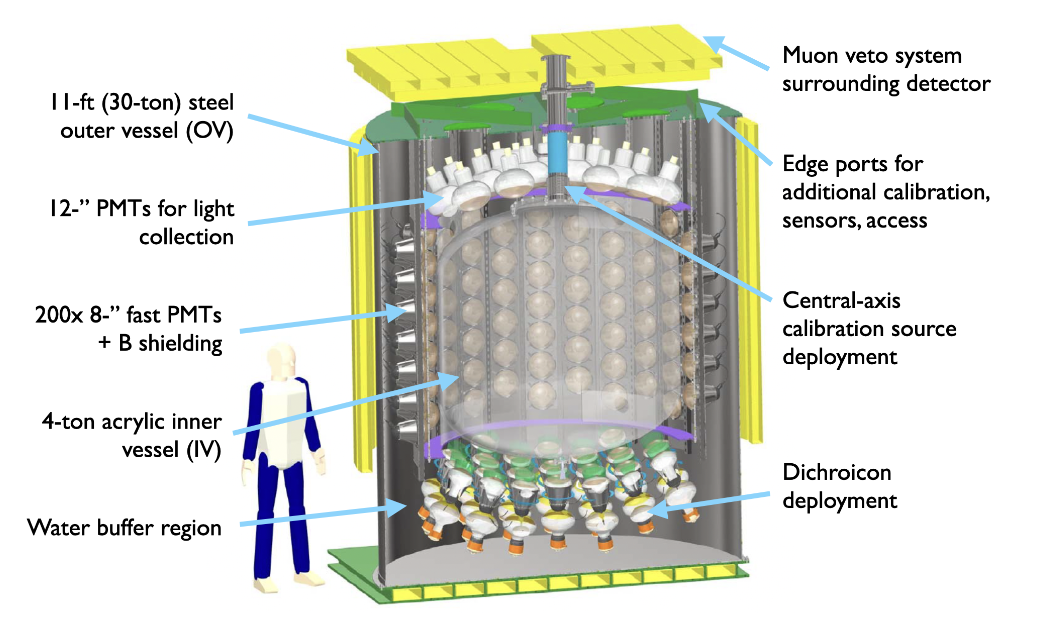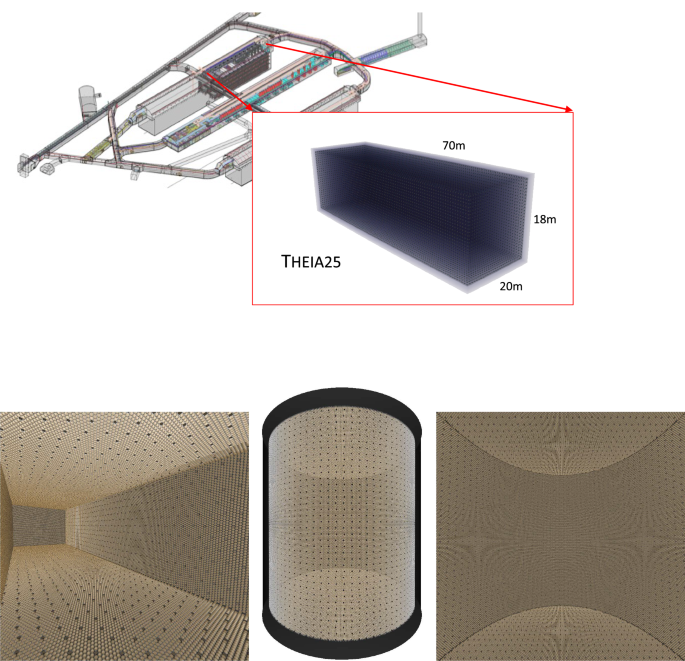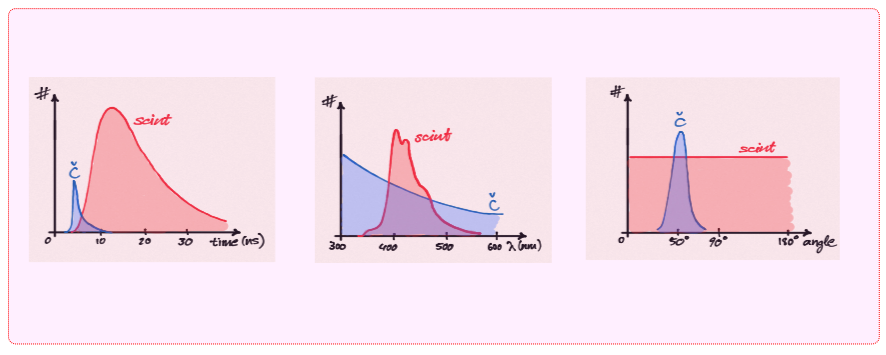
Fig 1. A schematic of the EOS detector (person shown for scale). A total of 240 PMTs will be deployed around a 4-tonne inner volume, made of UV transparent acrylic. The inner vessel and PMTs are contained within a 20-tonne outer stainless-steel vessel, which is filled with water. Radioactive calibration sources can be deployed through a port at the top of the detector.
EOS is a 20-tonne scintillation-based detector constructed at UC Berkeley. EOS provides a integrated test-bed for advanced R&D towards hybrid neutrino detectors, such as THEIA.
EOS will consist an acrylic vessel within a larger stainless steel tank (see Fig 1). The acrylic vessel will be filled with water-based liquid scintillator (WbLS) and the steel tank will be filled with water. Surrounding the acrylic vessel will be 204 8-inch R14688-100 high quantum efficiency, fast-timing photomultiplier tubes (PMTs). Additionally, 24 R11780 12-inch PMTs will be positioned at the top of the detector in order to further increase the coverage.
EOS is currently designed and constructed at UC Berkeley. Data-taking is planned to begin in 2024. The data-taking plan consists of using deployed, radioactive sources. Using these deployed sources, we will verify a detailed optical model of the WbLS (which is used to extrapolate to ktonne scale detectors, such as THEIA), and test advanced reconstruction algorithms designed to use both the Cherenkov and scintillation photons to reconstruct event position, energy, and direction.
EOS provides a test-bed for many emerging technologies. EOS can change the hybrid target material within the acrylic vessel to test different novel materials at a large-scale. Additionally, EOS will test fast-timing and novel photodetectors, including a planned deployedment of several dichroicons, likely positioned at the bottom of the detector, which provide spectral sorting of the short- and long- wavelength photons in order to separate the Cherenkov and scintillation components of the emitted light. Overall, EOS plans to enable a broad, world-leading physics and nonproliferation programs.

Fig 1. The THEIA detector. Upper panel: THEIA-25 sited in the planned fourth DUNE cavern; Lower left panel: an interior view of THEIA-25; Lower center panel: Exterior view of THEIA-100; Lower right panel: an interior view of THEIA-100
THEIA will be a novel, “hybrid” optical neutrino detector, with a rich physics program. THEIA will make use of a number of novel technologies to achieve successful hybrid event detection. Water-based liquid scintillator (WbLS), or slow scintillators can be used to enhance the Cherenkov signal by either reducing or delaying the scintillation component. The use of angular as well as timing information, with sufficiently fast photon detectors, can offer discrimination between Cherenkov and scintillation light for high-energy events even in a standard scintillator like LAB-PPO. Separation can also be enhanced using very fast photon detectors, such as LAPPDs (Large Area Picosecond Photo-Detectors) or spectral sorting using dichroic filters.
THEIA could reside in a cavern the size and shape of those planned for the Deep Underground Neutrino Experiment (DUNE), called Theia-25, and a larger 100-kton version (Theia-100) that could achieve an even broader and more sensitive scientific program (Fig. 1). THEIA is expected to allow for new scientific discovery across a broad spectrum of physics, including long baseline neutrino measurements of oscillations and CP violation searches, solar neutrino measurements of unprecedented precision and scope, and the potential to extend the reach of neutrinoless double beta decay searches to the mass scales implied by a Normal Ordering of neutrino masses. In addition, THEIA represents a major step forward for advancement in other fields – ranging from detection of the Diffuse Supernova Background flux to a measurement of geo-neutrinos with unprecedented statistics.

Fig 1. Several WbLS samples produced at Brookhaven National Lab shown compared to liquid scintillator and water.
Fig 2. The dichroicon -- a Winston cone concentrator built from dichroic filters. This version has a central dichroic longpass filter and dichroic shortpass filters along the barrell.
Fig 3. A possible design for the dichroicon, with the PMT placements designed to detect the Cherenkov and scintillation photons.
Future hybrid neutrino detectors will disinguish between the Cherenkov and scintillation signals emitted by the target material as charged particles pass through it. By doing so, these hybrid detectors can achieve unprecedented event imaging capabilities, resulting background rejection for a variety of low- and high- energy neutrino measurements. Eos will demonstrate the impact of several cutting-edge technologies that can enable future larger scale hybrid neutrino detectors.
EOS will be filled with WbLS, a mixture of liquid scintillator and water, that reduces the total scintillation light relative to 'pure' liquid scintillators, to enhance the ratio of collected Cherenkov to scintillation photons. The fraction of scintillator within the WbLS can be controlled, allowing one to tune the optical properties (light yield, attenuation, etc.) of the target medium. In addition, WbLS has a singificantly longer attenuation length than liquid scintillators, a key advantage for enormous detectors such as THEIA , where the average path length for the optical photons can be many meters. Fig. 1 shows a picture of several WbLS samples produced at Brookhaven Lab.
The dichroicon (see Fig 2.) is a Winston-cone shaped concentrator built from dichroic filters. By using shortpass dichroic filters in the barrell of the concentrator and a longpass dichroic filter at the aperture, one can short the long-wavelength photons (primarily Cherenkov) to a photodetector at the aperture, while allowing the short-wavelength photons (primarily scintillation) to pass through the dichroicon towards a large area PMT position behind the device. A possible design for the dichroicon, with the PMT placements, is shown in Fig. 3.
Another key technology for the hybrid technology is photodetectors with very fast timing responses. For Eos, we plan to utilize a newly developed, large-area (8-inch diameter) Hamamatsu PMT called the R14688-100. The R14688-100 has a high quantum efficiency (the photocathode is made from superbialkali with a maximum efficiency of about 35%) and is expected to have a transit time spread (TTS) of 900 ps (FWHM).

Fig 1. A schematic showing possible methods for separating Cherenkov and scintillation photons. From left to right, one can use the prompt arrival times, the broad wavelegth spectrum, and the directionality of the Cherenkov photons to distinguish them. Some examples of technologies that enable one to take advantage of these distinction are fast photodetectors, spectral sorting using dichroicons, and WbLS.
Hybrid detectors have the potential to revolutionize neutrino event detection by providing unique imaging captabilities that improve reconstruction performance and reduce backgrounds. These perormance enhancements are expected to improve physics sensitivies for low- and high- energy neutrino measurements, such as for solar neutrinos, geoneutrinos, etc. In addition, this hybrid techonology has the possibility to significantly impact future detectors that hope to perform far-field reactor monitoring for nonproliferation purposes. Eos provides an integrated test-bed for many of the technologies that will enable ktonne-scale hybrid detectors.